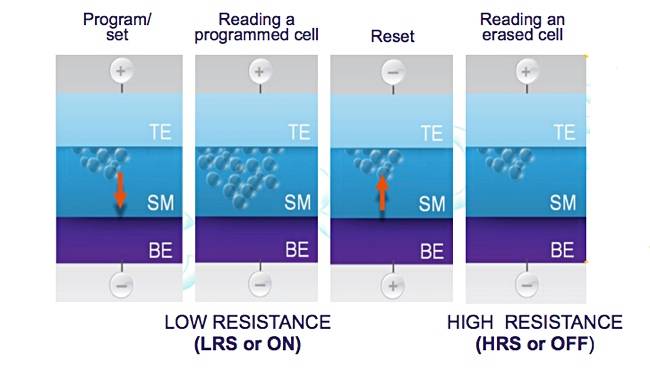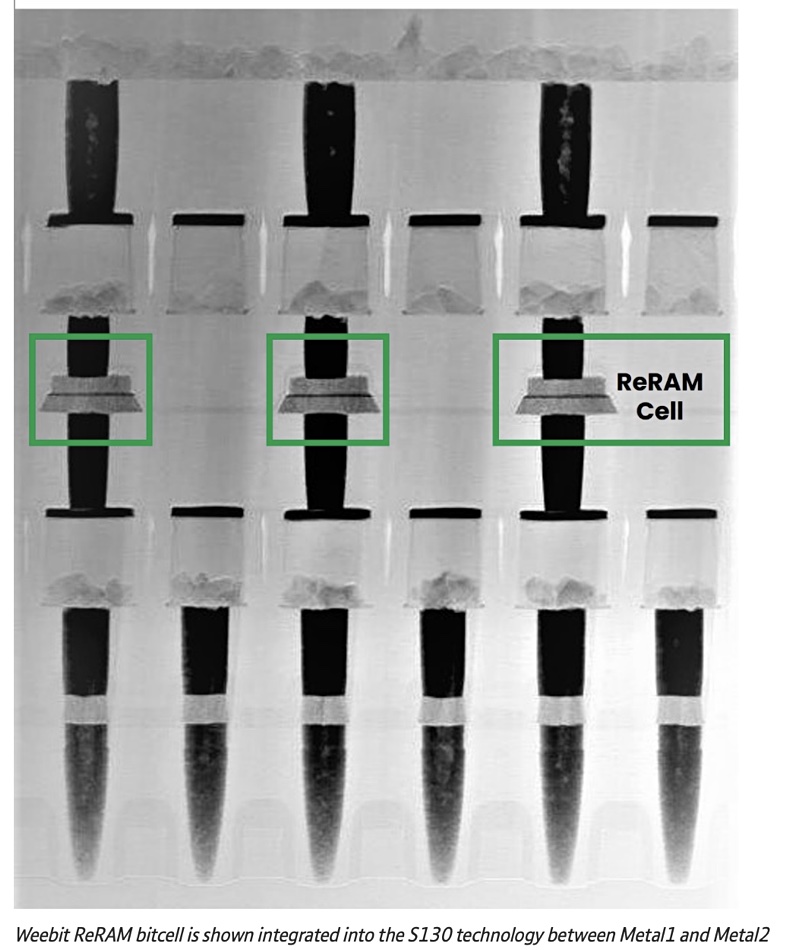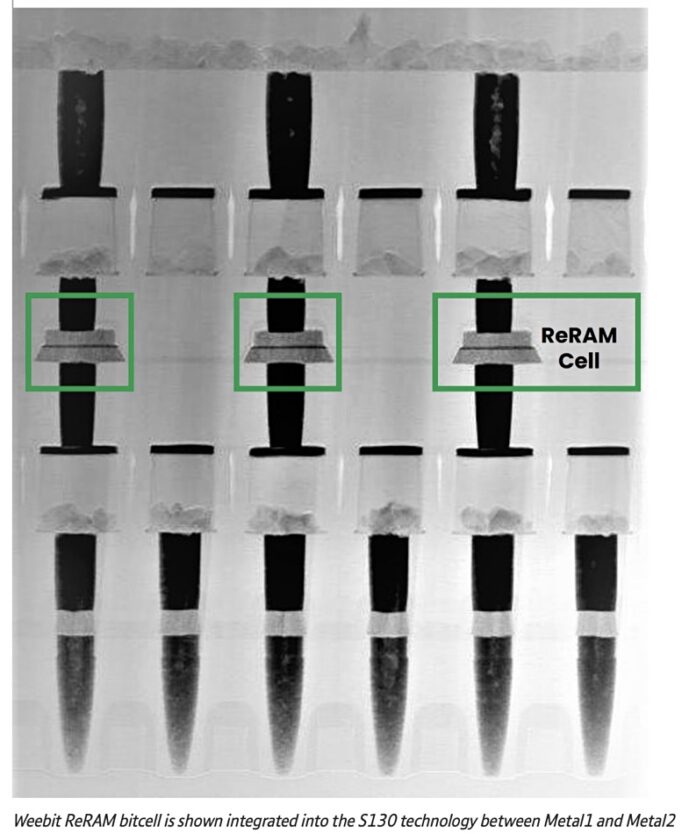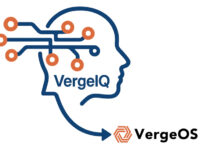Analysis: Resistive RAM (reRAM) startup Intrinsic Semiconductor Technologies has just raised $9.73 million in funding and grants to expand its engineering team and bring its product to market. Competitors have product in the market already (CrossBar) or IP is available from a foundry (Weebit Nano). What are Intrinsic’s chances?
ReRAM is a fast non-volatile storage-class memory relying on the formation of electrically conducting oxygen vacancy filaments through an otherwise insulating medium. Research discovered that sending a current through silicon oxide could counteract its inherent insulator property and create a silicon crystal (oxygen vacancy) pathway or filament. Electrical pulses could then break and reconnect this filament, changing the resistance levels from low to high – the binary signalling mechanism.
The tech is said to be as fast to read as SRAM (static random access memory), but lower cost with reduced power consumption and non-volatility. It retains data without needing constant power, unlike SRAM, or periodic power refreshes as with DRAM. Weebit and Intrinsic use a silicon oxide base material and a crosspoint-style architecture. CrossBar said its ReRAM is not oxide-based but does use a silicon-based switching material. It also has a crosspoint design.
ReRAM can be fabricated using CMOS techniques, like processors, and so embedded in microprocessor chips or other logic wafers. This embedding restricts its market progress as each design is unique, and microprocessors and switches that could need ReRAM are not necessarily high-volume items. This limits ReRAM revenue opportunities.
The market for external, non-embedded or discrete ReRAM memory is different. Object Analysis chief Jim Handy told us: “Our projection for discrete or stand-alone memory chips is … only $1.4 billion by 2031. It’s still early enough in the market that we are uncertain whether this will be ReRAM, or MRAM, or FRAM, or even something else. All of these are excellent technologies, and although MRAM currently has volume leadership, it doesn’t run in a high enough volume to have shut out any of its competition.”
Overcoming scale limitations
Overall, ReRAM tech has been positioned as overcoming the scaling limitations of flash, and as SRAM and NOR replacement technology – only it does not seem to be happening. We note that none of the major DRAM nor NAND vendors have yet announced any significant ReRAM projects or products. It seems the technology and its prospects, as far as they are concerned, are just not relevant – yet.
Handy said: “Emerging memories are a tough business! All emerging memory companies have hoped that an important opportunity would open as soon as established technologies ran into their scaling wall. That wall keeps getting moved. NAND flash was the first to do that – it couldn’t scale past 15nm. The industry went 3D, and this thwarted attempts to make ReRAM replace NAND after 15nm.
“Now we’re seeing embedded NOR stop at 28nm and embedded SRAM is slowing its scaling too, although SRAM doesn’t hit a brick wall the way that NAND and NOR have. The embedded market is addressing the NOR issue two ways. One is to switch from NOR flash to embedded ReRAM or MRAM, and the other is to re-architect the system. For re-architecture I have seen systems that combine an inexpensive external NOR with large SRAM caches on the SoC, and I have heard rumblings of other approaches like NVM chiplets.”
Objective Analysis and Coughlin Associates have published a report on emerging memories and estimates that embedded NOR will largely be replaced by an embedded emerging memory for all process nodes smaller than 28nm. They projected wafer shipments for SoCs at these nodes, and estimated the market value at $44 billion by 2031. That is a large market and will be taken, in their view, by ReRAM or MRAM.
Another an industry analyst said of MRAM (magneto-resistive RAM): “I think MRAM is faster and potentially better. I am not sure of why people would use ReRAM vs MRAM. Maybe for integration. But I can get MRAM solutions and embedded MRAM today up to 1Gbit.”
CrossBar
CrossBar is the oldest of the three ReRAM startups, having been founded in 2010. It is also the richest in funding terms, having raised $130.9 million, with the last round being a $20.1 million venture round in 2019. The funding round occurred the same time as a new CEO came on board, Dr Ker Zhang, who is also an exec-in-residence at Kleiner Perkins. He’s now listed as CrossBar’s exec chairman with president Mark Davis now having the CEO position.

CrossBar licenses its technology to SoC and memory companies as off-the-shelf or custom IP cores. The technology starts at 40nm and scales below 10nm. It enables cost-effective, low latency, high speed and low energy code execution and data storage memory products, or so it says on the tin. Depending on the business model, the IP cores can be provided to customers as hard macros that can be integrated into SoC or FPGA devices or used as standalone memory chips. Supported densities are from 8 Gbits (1 GByte) to 1 Terabyte, or custom sizes.
It says it is exploiting the benefits of its ReRAM cell for MTP (Multi-Time Programmable), FTP (Few-Time Programmable) and OTP (One-Time Programmable) memories as well as physical unclonable function (PUF) security keys, providing superior protection, simpler implementations, higher speed processing and semiconductor fabrication synergy with embedded ReRAM memories.
CrossBar talked in April 2022 about its ReRAM being resistive to attempts to read its contents through invasive physical hacking. It is not feasible to externally read the physical ReRAM cell electrically, magnetically or through imaging techniques even after delamination of the silicon. That’s all very well, but the SRAM and NOR markets have not been noticeably stunted by this problem.
Ashish Pancholi, CrossBar VP for marketing and sales, told us: “CrossBar continues to work primarily with licensees and partners of our ReRAM technology. This includes 12nm technology for a product targeting tapeout this year at a commercial foundry as well as low and high-density variants of the technology under development at a different licensee-owned fab.”
“In parallel with the ReRAM memory focused development, CrossBar is also working on advanced IC products focusing on secure processing, including associated embedded memory (not public information yet). On the financial side CrossBar remains in excellent financial health with revenue streams from licensing agreements.”
Weebit Nano
Weebit Nano, founded in 2014 and with $75 million in funding, has taken nine years to get its ReRAM available in the Skywater fab for customers needing embedded ReRAM to use in the products they contract Skywater to make.
Weebit says its ReRAM has DRAM-class speed (100ns write) and endurance (~1 million write cycles and 10-year retention. It is relatively straightforward for adoption by semiconductor fabs, cost effective, has enhanced endurance and retention at high temperature ranges, and is tolerant to radiation and electromagnetic fields, the company says.

Skywater operates a technology foundry for integrated circuit volume manufacturing. Weebit and Skywater have jointly transferred Weebit’s ReRAM technology to SkyWater’s production fab and qualified it for volume manufacturing. Demo chips have been tested and proved to be fully functional. The chips are being qualified and used for customer demos, testing and prototyping.
The industry analyst has positive views about Weebit: “It’s providing embedded ReRAM solutions for Skywater and other non-major foundries. I think it is a great idea. They could also attack the NOR market. They are optimized for niche and embedded … and they have solid chip level data.”
Intrinsic Semiconductor Technology
Six years after it was founded in 2017, the UK’s Intrinsic has only just raised its first real slug of cash after a $1.8 million seed round in 2021. That funded enough development to prove its ReRAM concept in theory, and it has just raised $9.73 million in a combined venture round and grant. That should fund an enlarged engineering team to build a demonstration product.
Asked about Intrinsic, our analyst said: “I would list them at five-plus years behind Weebit and probably 7-10 years behind Intel, TSMC, and Global.” We’ve also contacted Intrinsic to find out more about its ReRAM activities.
Future players
Handy told us: “It is widely known that the current memory leaders will reach their scaling limit, and the investments made in emerging memory technologies are based on that understanding, but the geniuses who develop new DRAM and NAND flash technologies still seem to have a number of options to continue to drive the cost out of those technologies.
“As far as I know, all leading memory makers have multiple research efforts pursuing more than one of these technologies. Several processor companies are also researching alternative technologies, as are almost all foundries.”
The ReRAM startups could find themselves facing major players in a few years time, players with deep financial pockets.








